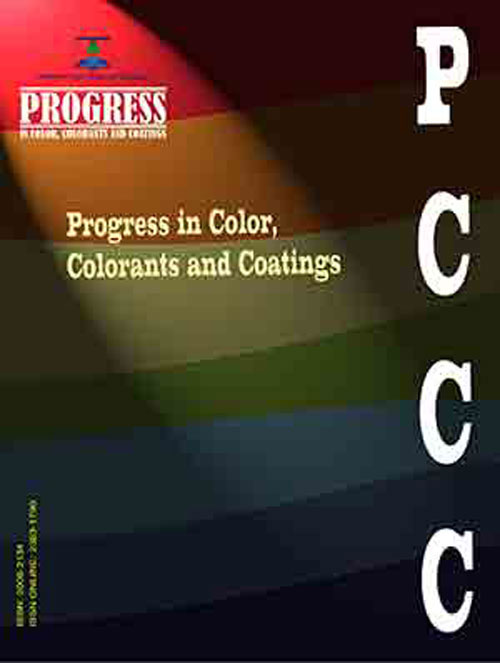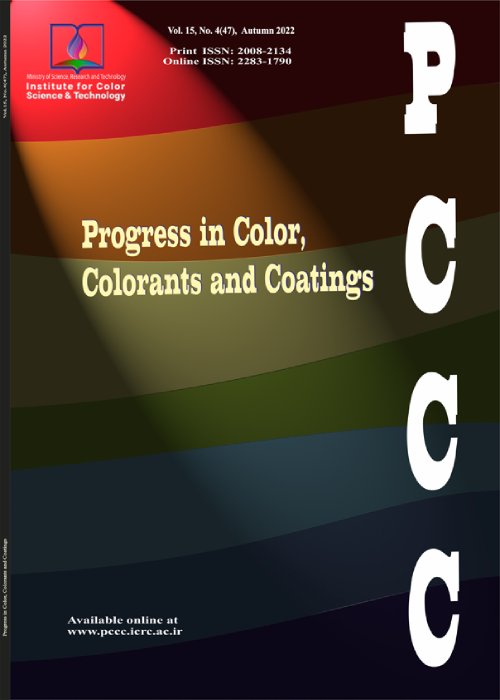فهرست مطالب

Progress in Color, Colorants and Coatings
Volume:13 Issue: 2, Spring 2020
- تاریخ انتشار: 1398/10/23
- تعداد عناوین: 6
-
-
Pages 75-83
Due to the importance of super-hydrophobic silica aerogel powder as a material in the field of energy saving, its wettability in the presence of various surfactants was investigated. One anionic and two non-ionic surfactants with different molecular structures were used as wetting and dispersing agents. Wetting properties of the aerogel powders were investigated by the contact angle measurements based on sessile drop method. The experimental results demonstrated that the silica aerogel powders are highly hydrophobic which is attributed to their surface treatment with the agents containing organic end groups. Moreover, it was found that anionic surfactant (Sulfosuccinate) was more efficient than non-ionic surfactants (Alkyl EO/PO copolymer and OctylphenolEthoxylate) in reducing the contact angle of water on silica aerogel powders. Further, the sessile drop method with slide and adhesive gave consistent data with good reproducibility for the investigated powders.
Keywords: Silica aerogel, Wettability, Contact angle, Sessile drop, Surfactant -
Pages 85-92
Aseries of samples was sintered from nanometric BaTiO3 powder by spark plasma sintering (SPS). Sintered tablets were polished, sputtered by aluminum to create electrode system and tested in DC and AC electric fields. The results were correlated with the SPS processing parameters and are discussed in connection with other BaTiO3 samples produced by SPS with or without additional heat treatment. Majority of our SPS fired samples had, even without subsequent thermal treatment, advantageous combination of high permittivity, DC resistivity and low loss factor, seldom reported for SPS technology. Samples were tested also in annealed state and compared with as-sintered ones.
Keywords: BaTiO3, Spark plasma sintering, Electrical properties, Annealing -
Pages 93-104
Near infrared and visible reflectance properties of brown mass dyed poly(ethylene terephthalate) melt spun filament yarns were studied compared to natural brown hue of desert areas. Pigment Red 177, Pigment Green 7 and carbon black particles were used in this investigation. Near-infrared reflectance, mechanical and thermal properties as well as crystallinity of the camouflage poly(ethylene terephthalate) mass dyed filament yarns were measured. The obtained result indicated that by using an optimal content of the mentioned colored pigments and carbon black particles during the melt spinning operation could be achieved to desirable near infrared reflectance properties in the poly(ethylene terephthalate) drawn filament yarns. Also, mechanical properties of the samples were acceptable evaluated. The samples with the highest concentration of pigments had the highest percentage of crystallinity. XRD results indicated that 2 sample with the highest concentration of pigments and additives among other samples had the greatest distance between the crystalline plates. Maximum space between crystal layers is about 4.01-4.08 Å. Also, microstructural uniformity of the sample was confirmed by a low variation of samples.
Keywords: Near infrared, Reflectance properties, Poly(ethylene terephthalate) filament yarn, Melt spinning, Carbon black -
Pages 105-119
This paper examines the role of protonation on the photochromic reactions of multi-responsive phenyl amine diarylethene derivatives (PA-DAEs). Reversible protonation and deprotonation provide a secondary stimulus for controlling the properties of light-responsive PA-DAEs, including solubility and thermal stability. For this reason, the phenylamine substituted DAEs were synthesized using a novel and efficient microwave-assisted synthetic route. Steady-state spectroscopy results indicated that the photocyclization and photocycloreversion reactions were reversible at different pH values. Even though, the acidic condition caused red-shift of the visible light absorption bands and generated a new absorption band at near-IR to IR region in the closed-ring structure but made blue-shift in the absorption spectra of the open-ring isomers. Also, it was showed that the excess amount of proton locked back the photochromic reaction. Results also indicated that the protonated closed-ring isomers of PA-DAEs are hydrophilic, whereas the deprotonated forms and protonated open-ring forms are hydrophobic. In addition to photoswitching and solubility of PA-DAEs under irradiation at different light wavelengths, the thermal stability of P-type PA-DAEs was also monitored in the presence of trifluoroacetic acid at different temperatures as external stimuli.
Keywords: Multi-responsive photoswitches, Phenylamine-substituted Diarylethenes, pH, Phase transfer, Thermal stability -
Pages 121-130
Spectral images are the most valuable data than can be achieved using 2D sensors. Spectral estimation using data with a few channel cameras has been the subject of many studies. It is common to use color filters in front of the lens for increasing dimensionality of data. However, spectral estimations are prone to suffer from colorimetric errors. To address this problem it was shown that this problem is a special case of error-free spectral estimation problem. Considering the fact that most of RGB cameras tend to be colorimetric, using geometrical modeling of the problem, it was shown that adding a shoot with bare lens to the sensor’s data can solve the problem. The notion has been tested in different scenarios and the efficiency of the proposed method has been proved in the scenarios. Results showed that if the camera is acceptably colorimetric, the proposed method can even leads to error-free colorimetric performance.
Keywords: Multispectral imaging, Optical filter, RGB camera, Spectral reconstruction -
Pages 131-141
In this work, it was demonstrated that the anti-corrosion performance of the polypyrrole (PPy) coatings on mild steel can be affected by electrodeposition method, electrosynthesis solvent composition and ZnO nanoparticles concentration. Three different electrodeposition methods, namely, cyclic voltammetry, galvanostatic and potentiostatic techniques were empolyed. The anti-corrosion performance of the PPy coatings was investigated by electrochemical impedance spectroscopy. The PPy prepared by potentiostatic method exhibited the best performance against corrosion of mild steel in 3.5% NaCl solution. Then, different mixtures of H2O/ethanol were investigated as electrosynthesis solvents for the preparation of PPy coatings on mild steel via optimized electrodeposition mode (i.e. potentiostatic). Evaluation of the prepared coatings introduced the pure water as the optimum solvent for the PPy electrodeposition. Lastly, the investigation of different concentrations of ZnO nanoparticles proved that the PPy coating containing 0.025% ZnO nanoparticles was the best coating against the corrosion of mild steel in the NaCl solution.
Keywords: Electrosynthesized polypyrrole, Corrosion protection, Nanoparticles, Electrochemical impedance spectroscopy


